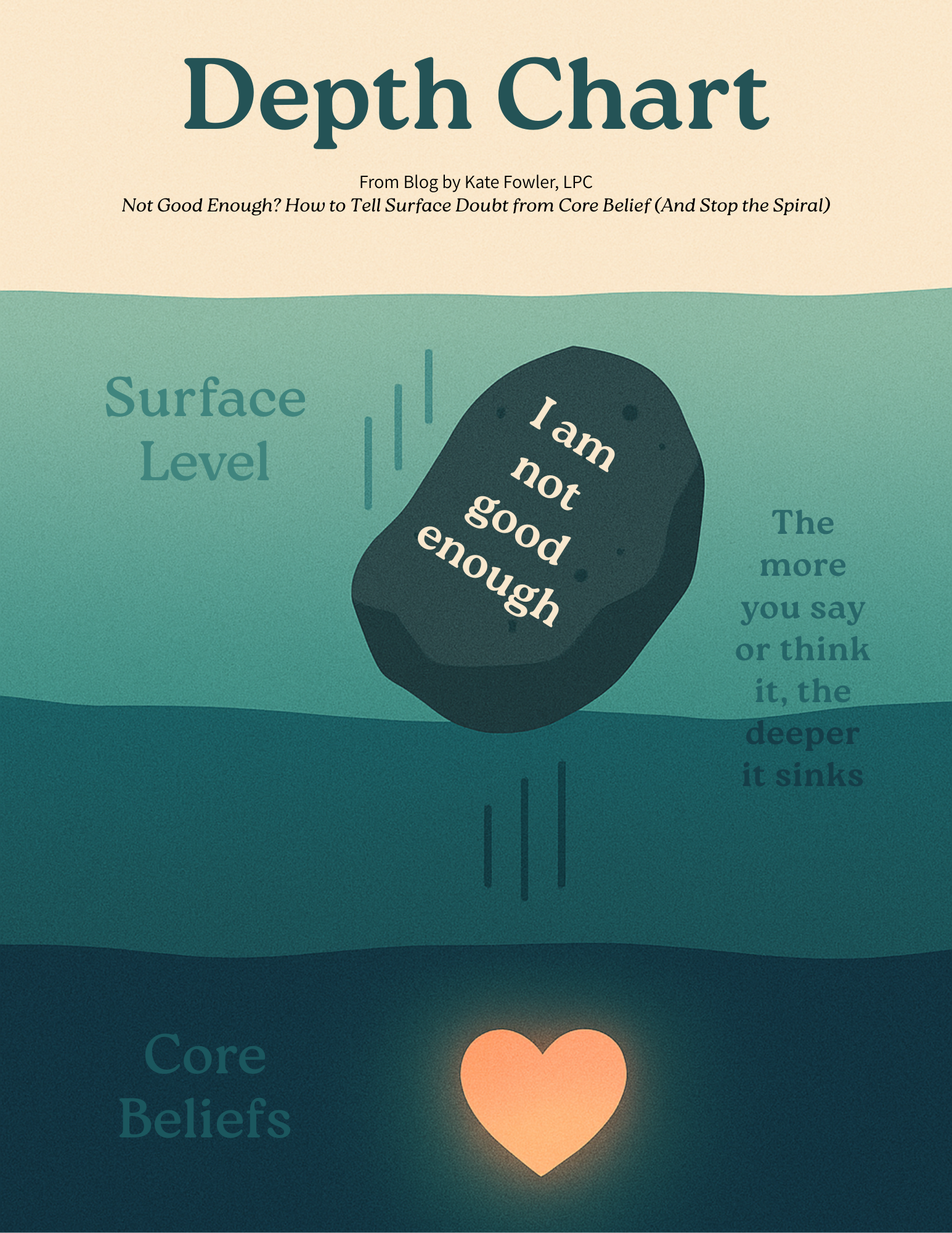The Depth Chart: Understanding “Not Good Enough” from Surface to Core
"I’m not good enough."
If I had a dollar for every time I’ve heard that phrase—or seen it silently driving behavior beneath the surface—I could retire early. It’s the #1 negative core belief I see in my therapy practice.
But here’s the thing: “not good enough” isn’t always the same thing. There’s a difference between not being the best fit for something at the surface level and believing you’re not good enough at your core. And that difference matters—because the deeper it goes, the more power it holds.
The Depth Chart: Surface to Core
Let’s use a visual metaphor: a depth chart. On the surface are the roles you play, the goals you go after, the things you try. Deeper down are your internalized beliefs—the unspoken “truths” you’ve absorbed about yourself.
Maybe you didn’t get the promotion. Maybe you weren’t chosen for the dance team. Maybe your application didn’t stand out this time. Those are surface-level moments. They can sting. They can disappoint. But they don’t mean you, as a human being, are inadequate.
But when we confuse surface outcomes with core worth, things get tricky. A simple disappointment becomes internalized:
“I didn’t get the part” turns into “I’m not talented.”
“They didn’t choose me” turns into “I’m not worthy.”
“I messed that up” turns into “I’m a failure.”
And often, that confusion is fueled by comparison.
We don’t just evaluate ourselves in isolation—we stack ourselves up next to someone else. She’s thinner. He’s more successful. They’re more likable. And suddenly, it’s not just “I didn’t get it,” it’s “They got it because they’re better than me—and I’ll never measure up.”
Comparison is a surface-level tool that can easily become a core-level wound if left unchecked.
Over time, those surface messages stack up and sink down—unless we actively do something about them.
Surface vs. Core: Why the Difference Matters
Surface level: Temporary, contextual, specific.
“I wasn’t the right fit for that job.”
“That person didn’t choose me romantically.”
“I missed the mark this time.”
“Someone else outshined me in that one area.”
Core level: Ongoing, global, identity-based.
“I’m not good enough.”
“No one will ever pick me.”
“I always screw things up.”
“Everyone is better than me, and that means I don’t belong.”
When a surface rejection—or a single unfavorable comparison—becomes a core belief, it starts to influence how you see yourself across every area of life—not just that one situation. It becomes the lens through which you interpret future experiences. And it subtly (or not so subtly) changes how you show up in relationships, work, and self-talk.
How to Keep Surface-Level Doubts from Becoming Core-Level Beliefs
Catch the narrative in the moment.
When something disappointing happens, listen to the story your brain starts telling. Is it about this moment—or about who you are? Name the difference.
Talk to yourself like someone you care about.
You wouldn't tell your best friend, “You didn’t get the job because you’re worthless.” You’d say, “That sucks—but it doesn’t define you.” Offer yourself the same compassion.
Collect counter-evidence.
Make a mental (or literal) list of times you were chosen, trusted, valued, or successful. Just because this one thing didn’t work out doesn’t erase the rest of your story.
Ask: “Is this about identity or circumstance?”
Identity says: “I’m not enough.”
Circumstance says: “This wasn’t the right match today.”
Train your mind to separate the two.Watch where comparison is leading you.
Comparison will always exist—it’s human. But when you notice you’re comparing, ask yourself:
Is this motivating or defeating me?
Am I using this as data or as a definition of my worth?
Try to keep comparison at the surface level: just one observation, not a value judgment. Because the minute comparison becomes identity, it digs deep and reinforces the “not good enough” belief.Explore the origin.
If “I’m not good enough” feels too familiar, it may be coming from childhood messages, cultural pressures, or old wounds. Working with a therapist can help you trace it back and unhook it from your identity.
Final Thoughts
We’re not all going to be Dallas Cowboy cheerleaders or CEOs or viral influencers. That’s okay. Being “not good enough” for a specific opportunity doesn’t mean you are fundamentally flawed.
You are allowed to feel disappointed without being defective.
You are allowed to struggle without being broken.
You are allowed to be human without being “not enough.”
Your worth isn’t measured by your most recent success or failure—or by how you compare to someone else.
It lives deeper than that—and it’s time to protect it.
Ready to explore what’s beneath the surface?
If you’ve been carrying the weight of “I’m not good enough,” you don’t have to unpack it alone. I offer free 15-minute consultations to help you see if therapy is the right next step. Let’s talk about what’s been sinking in—and how to shift it.
